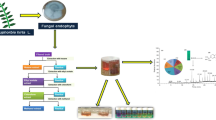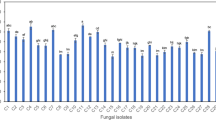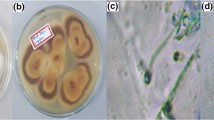Abstract
Endophytic fungi isolated from the insectivorous plant Drosera burmannii were tested for their antioxidant potential. The isolate Dro2 was found to have superlative antioxidant activity of the culture broth, scavenging 57.6 ± 0.2% of 2,2-diphenyl-1-picrylhydrazyl free radical. 5.8S rDNA homology led to identification of the isolate as a new strain and it has been named Mucor irregularis isolate Dro2. Optimization studies revealed ethyl acetate to be optimum for extraction of the antioxidant compounds. The crude solvent extract showed 89.6% 2,2'-azino-bis(3-ethylbenzothiazoline-6-sulfonic acid) (ABTS) free radical scavenging activity with respect to 86.1% ABTS radical reducing antioxidant power of ascorbic acid. The sample exhibited 824.0 ± 25.5 µM reducing ability in assay, compared to 1204.0 ± 17.8 µM for ascorbic acid. The sample extract displayed IC50DPPH of 53.6 µg/mL. The crude extract was further purified through various chromatography techniques and GC-MS was performed on the purified active fractions to ascertain the nature and identify compounds conferring antioxidant potential to the endophytic fungal isolate. The active fractions were found to comprise multitudinous compounds with varied biological activity. Antioxidant compounds, such as 2,4-di-tert-butylphenol, myristic acid, pyrrolo[1,2-a]pyrazine-1,4-dione, hexahydro-3-(2-methylpropyl)-, palmitic acid, were found in significant abundance. This study substantiates the candidature of the endophytic fungus Mucor irregularis isolate Dro2 as an industrially capable source for obtaining bioactive compounds, particularly antioxidant compounds.






Similar content being viewed by others
REFERENCES
Pham-Huy, L.A., He, H., and Pham-Huy, C., Int. J. Biomed. Sci., 2009, vol. 4, no. 2, pp. 89–96.
Tyrell, R.M., Biochem. Soc. Symp., 1995, vol. 61, pp. 47–53.
Halliwell, B., Antioxidants in Disease Mechanisms and Therapy, August, J.T., Murad, F., Anders, M.W., Coyle, J.T., and Packer, L., Eds., Cambridge: Academic, 1996, vol. 38.
Ahuja, N., Singh, H.P., Batish, D.R., and Kohli, R.K., Pestic. Biochem. Phys., 2015, vol. 118, pp. 64–70.
Strobel, G., Daisy, B., Castillo, U., and Harper, J., J. Nat. Prod., 2004, vol. 67, no. 2, pp. 257–268.
Woropong, J., Strobel, G.A., Ford, E.J., Li, J.Y., Baird, G., and Hess, W.M., Mycotaxon, 2001, vol. 79, pp. 67–79.
Blois, M.S., Nature, 1958, vol. 181, pp. 1199–1200.
Murray, M.G. and Thompson, W.F., Nucleic Acids Res., 1980, vol. 9, no. 19, pp. 4321–4325.
Pan, F., Hou, K., Gao, F., Hu, B., Chen, Q., and Wu, W., Phytomedicine, 2014, vol. 21, no. 8–9, pp. 1104–1109.
Tamura, K., Peterson, D., Peterson, N., Stecher, G., Nei, M., and Kumar, S., Mol. Biol. Evol., 2011, vol. 28, no. 19, pp. 2731–2739.
Rajurkar, N.S. and Hande, S.M., J. Pharm. Sci., 2011, vol. 73, no. 2, pp. 146–151.
Pan, F., Su, T.J., Cai, S.M., and Wu, W., Sci. Rep., 2017, vol. 7, art. 42008.
Mensor, L.L., Menezes, F.S., Leitão, G.G., Reis, A.S., dos Santos, T.C., Coube, C.S., and Leitão, S.G., Phytother. Res., 2001, vol. 15, no. 2, pp. 127–130.
Quilliam, R.S. and Jones, D.L., Mycorrhiza, 2010, vol. 20, pp. 341–348.
Akone, S., Daletos, G., Lin, W., and Proksch, P., Z. Naturforsch. C, 2016, vol. 71, no. 1–2, pp. 15–19.
Gao, S.S., Li, X.M., Williams, K., Proksch, P., Ji, N.Y., and Wang, B.G., J. Nat. Prod., 2016, vol. 79, no. 8, pp. 2066–2074.
Krishnamoorthy, K. and Subramaniam, P., Int. Sch. Res. Notices, 2014, vol. 2014 567409.
Pan, Y., Zheng, W., and Yang, S., Nat. Prod. Res., 2019, vol. 21, pp. 1–4.
Varsha, K.K., Devendra, L., Shilpa, G., Priya, S., Pandey, A., and Nampoothiri, K.M., Int. J. Food Microbiol., 2015, vol. 211, pp. 44–50.
Pan, F., Su, T.J., Deng, K.L., and Wu, W., Mycosystema, 2017, vol. 36, no. 6, pp. 752–765.
Al-Majedy, Y., Al-Amiery, A., Kadhum, A.A., and BakarMohamad, A., Syst. Rev. Pharm., 2017, vol. 8, no. 1, pp. 24–30.
Shastry, R.P. and Aman, M., Curr. Bioact. Compd., 2019, vol. 15, p. 1.
Qin, W., Liu, C., Jiang, W., Xue, Y., Wang, G., and Liu, S. BMC Microbiol., 2019, vol. 19, p. 50.
Palmieri, A. and Petrini, M., Nat. Prod. Rep., 2018, vol. 36, no. 3, pp. 490–530.
Gos, F.M.W.R., Savi, D.C., Shaaban, K.A., Thorson, J.S., Aluizio, R., Possiede, Y.M., et al., Front. Microbiol., 2017, vol. 8, art. 1642.
Sanjenbam, P., Gopal, J.V., and Kannabiran, K., Appl. Biochem. Microbiol., 2014, vol. 50, no. 5, pp. 429–499.
Awla, H.K., Kadir, J., Othman, R., Rashid, T.S., and Wong, M.Y., Am. J. Plant Sci., 2016, vol. 7, pp. 1077–1085.
Sheoran, N., ValiyaNadakkakath, A., Munjal, V., Kundu, A., Subaharan, K., Venugopal, V., et al., Microbiol. Res., 2015, vol. 173, pp. 66–78.
Kaschula, C.H., Egan, T.J., Hunter, R., Basilico, N., Parapini, S., Taramelli, D., et al., J. Med. Chem., 2002, vol. 45, pp. 3531–3539.
Sivakumar, R., Jebanesan, A., Govindarajan, M., and Rajasekar, P., Asian Pac. J. Trop. Med., 2011, vol. 4, no. 9, pp.706–710.
Lata, R., Chowdhury, S., Gond, S.K., and White, J.F. Jr., Lett. Appl. Microbiol., 2018, vol. 66, no. 4, pp. 268–276.
Lubna, Asaf, S., Hamayun, M., Khan, A.L., Waqas, M., Khan, M.A., Jan, R., et al., Plant Physiol. Biochem., 2018, vol. 128, pp. 13–23.
Zhu, L., Li, T., Wang, C., Zhang, X., Xu, L., Xu, R., and Zhao, Z., Environ. Sci. Pollut. Res. Int., 2018, vol. 25, no. 35, pp. 35232–35241.
Ghate, N.B., Chaudhuri, D., Das, A., Panja, S., and Mandal, N., PLoS One, 2015, vol. 10, no. 5, art. e0128221. https://doi.org/10.1371/journal.pone.0128221
Strobel, G. and Daisy, B., Microbiol. Mol. Biol. Rev., 2003, vol. 67, no. 4, pp. 491–502.
Funding
Authors are grateful to the Council of Scientific and Industrial Research, India, for financial support in the form of junior research fellowship to SM.
Author information
Authors and Affiliations
Contributions
Conceptualization, experiments, data collection and analysis were performed by S. Mandal. S. Maity helped in chromatography, HPLC and GC-MS studies. Manuscript was prepared by S. Mandal. Insightful comments were received from S. Maity and D. Banerjee which helped in drafting the final version of the manuscript. All the research work was supervised by D. Banerjee.
Corresponding author
Ethics declarations
The authors declare that they have no conflicts of interest. This article does not contain any studies involving animals or human participants performed by any of the authors.
Rights and permissions
About this article
Cite this article
Mandal, S., Maity, S. & Banerjee, D. Antioxidative Compounds from the Secreted Metabolome of Strain ‘Mucor irregularis Isolate Dro2’—an Endophyte of the Carnivorous Plant Drosera burmannii. Appl Biochem Microbiol 57 (Suppl 1), S88–S97 (2021). https://doi.org/10.1134/S0003683821100069
Received:
Revised:
Accepted:
Published:
Issue Date:
DOI: https://doi.org/10.1134/S0003683821100069




